| Petunia | |
|---|---|
.jpg.webp) | |
| Petunia exserta flower | |
| Scientific classification | |
| Kingdom: | Plantae |
| Clade: | Tracheophytes |
| Clade: | Angiosperms |
| Clade: | Eudicots |
| Clade: | Asterids |
| Order: | Solanales |
| Family: | Solanaceae |
| Subfamily: | Petunioideae |
| Genus: | Petunia Juss. |
| Species | |
|
See text | |
Petunia is a genus of 20 species[1] of flowering plants of South American origin. The popular flower of the same name derived its epithet from the French, which took the word pétun, 'tobacco', from a Tupi–Guarani language. A tender perennial, most of the varieties seen in gardens are hybrids (Petunia × atkinsiana, also known as Petunia × hybrida).
Taxonomy
Petunia is a genus in the family Solanaceae, subfamily Petunioideae. Well known members of Solanaceae in other subfamilies include tobacco (subfamily Nicotianoideae), and the cape gooseberry, tomato, potato, deadly nightshade and chili pepper (subfamily Solanoideae).[2] Some botanists place the plants of the genus Calibrachoa in the genus Petunia,[3] but this is not accepted by others.[4][5][6] Petchoa is a hybrid genus derived from crossing Calibrachoa and Petunia.[7]
Species
Species include:[8]
- Petunia alpicola
- Petunia axillaris
- Petunia bajeensis
- Petunia bonjardinensis
- Petunia exserta
- Petunia guarapuavensis
- Petunia inflata
- Petunia integrifolia
- Petunia interior
- Petunia ledifolia
- Petunia littoralis
- Petunia mantiqueirensis
- Petunia occidentalis
- Petunia patagonica
- Petunia reitzii
- Petunia riograndensis
- Petunia saxicola
- Petunia scheideana
- Petunia villadiana
Ecology
Petunias are generally insect pollinated, with the exception of P. exserta, which is a rare, red-flowered, hummingbird-pollinated species. Most petunias are diploid with 14 chromosomes and are interfertile with other petunia species,[9][10] as well as with Calibrachoa.
The tubular flowers are favoured by some Lepidoptera species, including the Hummingbird hawk moth.[11]
Cultivation
Petunias can tolerate relatively harsh conditions and hot climates, but not frost. They need at least five hours of sunlight every day and flourish in moist soil and conditions of low atmospheric humidity. They are best grown from seed. Watering once a week should be sufficient in most regions. Hanging baskets and other containers need more frequent watering.[12] Maximum growth occurs in late spring. Applying fertilizer monthly or weekly, depending on the variety, will help the plant grow quickly.
AGM cultivars
The following is a selection of cultivars which have received the Royal Horticultural Society's Award of Garden Merit:
- Conchita Blueberry Frost = 'Conblue'[13]
- Conchita Evening Glow = 'Conglow'[14]
- Conchita Strawberry Frost = 'Constraw'[15]
- NightSky = 'Kleph15313' [16]
- 'Storm Lavender'[17]
- 'Storm Pink'[18]
- 'Storm Salmon'[19]
- Surfinia Pink Vein = 'Suntosol'[20]
- Surfinia Purple = 'Sunpurple'[21]
- Tumbelina Priscilla = 'Kerpril'[22]
Uses
Many species other than Petunia × atkinsiana are also gaining popularity in the home garden.[23] A wide range of flower colours, sizes, and plant architectures are available in both Petunia × atkinsiana and other species.[3]
Symbolism and folklore
The Maya and Inca believed that the scent of petunias had the power to ward off underworld monsters and spirits. Their flower-buds were bunched together for magical drinks.
Gallery
.jpg.webp) Red and white mixed petunia
Red and white mixed petunia Purple petunias with a white border
Purple petunias with a white border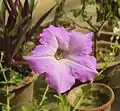 A form of Petunia axillaris with a light pink flower
A form of Petunia axillaris with a light pink flower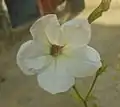 White Petunia axillaris
White Petunia axillaris A red petunia with a white border
A red petunia with a white border A cultivated form of petunia
A cultivated form of petunia.JPG.webp) Leaves of Petunia × atkinsiana
Leaves of Petunia × atkinsiana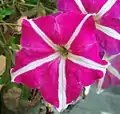 A cultivated form
A cultivated form Starry Night, found in Porto Alegre - Brazil.
Starry Night, found in Porto Alegre - Brazil. Pink Sky Petunia
Pink Sky Petunia Black Petunia
Black Petunia Pink Petunia in Holambra - Brazil
Pink Petunia in Holambra - Brazil Petunia x hybrida
Petunia x hybrida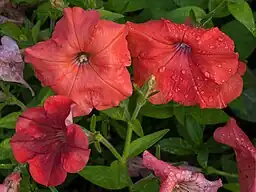 African Sunset, an orange petunia created with genetic modification
African Sunset, an orange petunia created with genetic modification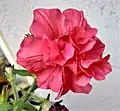 Petunia double petals
Petunia double petals Petunia blue double petals
Petunia blue double petals
References
- ↑ "The plant list: Petunia". Royal Botanic Garden Kew and Missouri Botanic Garden. Retrieved 17 March 2018.
- ↑ “Classification for Kingdom Plantae Down to Family Solanaceae”. Natural Resources Conservation Service. United States Department of Agriculture. 2009. Web. July 8, 2009.
- 1 2 Ellis, Barbara W. (1999). Taylor's Guide to Annuals. Boston: Houghton Mifflin Co.
- ↑ The Plant List: Petunia
- ↑ Ando, T.; Kokubun, H.; Watanabe, H.; Tanaka, N.; Yukawa, T.; Hashimoto, G.; Marchesi, E.; Suárez, E.; Basualdo, I.L. (2005). "Phylogenetic analysis of Petunia sensu Jussieu (Solanaceae) using chloroplast DNA RFLP". Annals of Botany. 96 (2): 289–297. doi:10.1093/aob/mci177. PMC 4246877. PMID 15944177.
- ↑ Mishiba, Kei-Ichiro; Ando, Toshio; Mii, Masahiro; Watanabe, Hitoshi; Kokubun, Hisashi; Hashimoto, Goro; Marchesi, Eduardo (2000). "Nuclear DNA Content as an Index Character Discriminating Taxa in the Genus Petunia sensu Jussieu (Solanaceae)". Annals of Botany. 85 (5): 665–673. doi:10.1006/anbo.2000.1122.
- ↑ The Value of Growing Petchoa SuperCal®. Ornamental News Oct 25 2012
- ↑ The Plant List, retrieved 13 September 2015
- ↑ Ando, T.; Nomura, M.; Tsukahara, J.; Watanabe, H.; Kokubun, H.; Tsukamoto, T.; Hashimoto, G.; Marchesi, E.; Kitching, I. J. (2001). "Reproductive isolation in a native population of Petunia sensu Jussieu (Solanaceae)". Annals of Botany. 88 (3): 403–413. doi:10.1006/anbo.2001.1485. JSTOR 42771064.
- ↑ Griesbach, R.J.(2007) in Flower breeding and genetics: Issues, challenges and opportunities for the 21st century, Petunia, ed Anderson N.O. (Springer, Dordrecht, The Netherlands), pp 301–336.
- ↑ Butterfly Conservation
- ↑ Brown, Deborah. “Growing Petunias” University of Minnesota Extension Office. University of Minnesota. 2009. Web. 25 June 2009. http://www.extension.umn.edu/distribution/horticulture/DG1120.html Archived 2013-10-26 at the Wayback Machine
- ↑ "Petunia Conchita Blueberry Frost='Conblue'". RHS. Retrieved 18 January 2021.
- ↑ "Petunia Conchita Evening Glow='Conglow'". RHS. Retrieved 18 January 2021.
- ↑ "Petunia Conchita Strawberry Frost='Constraw'". RHS. Retrieved 18 January 2021.
- ↑ "Petunia NightSky='Kleph15313'". RHS. Retrieved 18 January 2021.
- ↑ "Petunia × atkinsiana 'Storm Lavender'". RHS. Retrieved 18 January 2021.
- ↑ "Petunia × atkinsiana 'Storm Pink'". RHS. Retrieved 18 January 2021.
- ↑ "Petunia × atkinsiana 'Storm Salmon'". RHS. Retrieved 18 January 2021.
- ↑ "Petunia Surfinia Pink Vein='Suntosol'". RHS. Retrieved 18 January 2021.
- ↑ "Surfinia Purple='Sunpurple'". RHS. Retrieved 18 January 2021.
- ↑ "Petunia Tumbelina Priscilla='Kerpril'". RHS. Retrieved 18 January 2021.
- ↑ Armitage, Allan M. (2001). Armitage's Manual of Annuals, Biennials, and Half-Hardy Perennials. Portland: Timber Press.